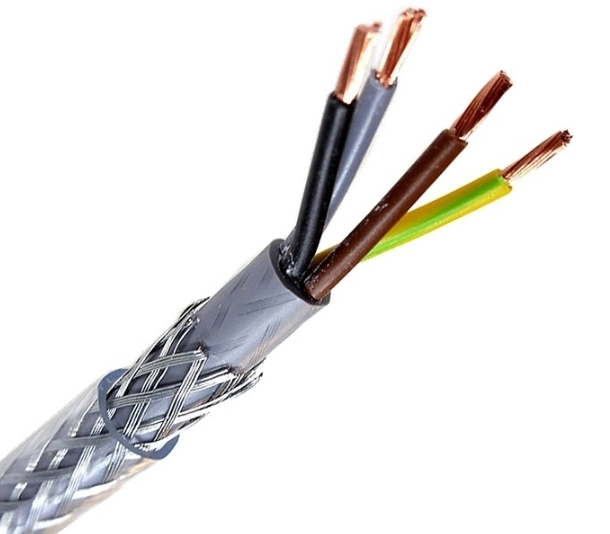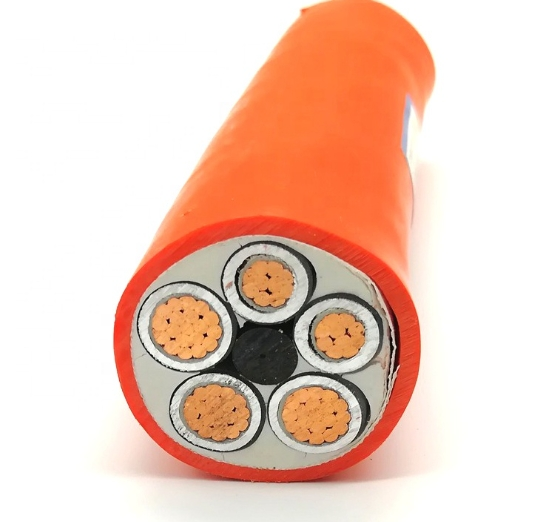Medium voltage cable (MV Cable) is designed to match facilities with higher voltage demands. Low voltage cable is not enough to support the higher voltage demand, and high voltage cable is higher than the demand and cost more, so people mostly choose medium voltage cables. Medium-voltage cable is power cable are usually used to carry medium voltage power. Let’s start by understanding the medium voltage cable meaning.
What is the medium voltage cable?
Unlike low voltage cable and high voltage cable, medium-voltage cables refer to working voltage of medium grade cable is 3.6kv to 35kv. MV cables are widely used in power systems, underground railways, petrochemicals, as well as commercial buildings and renewable energy projects to support power and signal transmission over medium distances. Medium voltage power cable is specially constructed to be resistant to interference, radiation and chemicals, mechanical damage and fire resistance, providing protection to the electrical cable and helping them to smoothly transport power from the distribution station to various applications at medium voltage levels.
Medium voltage cable construction
Because of their higher voltage levels and the need to carry higher electricity for project using, mv cable is somewhat more complex than lv cables in order to safely and efficiently transmit point power. Here’s a detailed description from the inside out.

Conductor: Generally, cable manufacturers use either copper or aluminium as the conductor for medium voltage cable. Copper has better conductivity than aluminium, but aluminium is less expensive than copper, so customers can choose according to their own situation;
Semiconductor Insulation: A layer of semiconductor material added to the metal shield creates a uniform electric plant around it and reduces the risk of electrical stress concentrations;
Insulation: The outer layer of the conductor is wrapped with a layer of XLPE insulation, which can effectively withstand ambient temperatures and chemical substances and maintain the voltage level to a large extent;
Shield: To make the medium voltage underground cable resistant to electromagnetic interference, the manufacturer adds a shield, usually made of metal, to the mv cable. A metallic shield (copper or aluminium) not only provides the cable with immunity to electromagnetic interference, but also protects the medium voltage electric cable from mechanical damage;
Armour: Generally made of steel or aluminium in the form of ribbons or filaments to provide additional protection to the cable;
Filler: Electrical cable manufacturers may choose to fill the gaps in the cable with non-conductive material to provide mechanical support for the cable;
Sheath: the outer layer of the electric cable is wrapped in a sheath made of PVC material to protect the inside of the cable from abrasion and moisture damage.
Medium-voltage cable construction can vary depending on the environment and local industry standards, and people can also customize special construction of medium-voltage cables for specific applications to ensure that they can use medium voltage cables in a better and safer way. Learn more about the medium voltage cable sizing below to make a quicker choice of medium voltage power cables.
Medium voltage cable size
The cross-sectional area of a MV cable is the size of the MV cable, which can vary depending on factors such as the medium voltage cable ampacity, voltage, temperature, environment and medium voltage power cable specification. Below is medium voltage cable size chart(IEC standard) for your reference.
| Nominal cross section of conductor (mm²) | 8.7kv/15kv | 8.7kv/15kv | 8.7kv/15kv | 26kv/35kv | 26kv/35kv | 26kv/35kv | Current carrying ampacity(amps)(underground) |
|---|---|---|---|---|---|---|---|
| Insulation thickness(mm) | Approx. overall diameter of cable(mm) | Approx. Weight of cable(kg/km) | Insulation thickness(mm) | Approx. overall diameter of cable(mm) | Approx. Weight of cable(kg/km) | ||
| 35 | 4.5 | 52 | 3790 | 10.5 | 62 | 7350 | 150 |
| 50 | 4.5 | 55.5 | 4390 | 10.5 | 87 | 8850 | 190 |
| 70 | 4.5 | 59.2 | 5260 | 10.5 | 90.5 | 9910 | 230 |
| 95 | 4.5 | 63.4 | 6320 | 10.5 | 94 | 11250 | 270 |
| 120 | 4.5 | 67 | 7260 | 10.5 | 98.5 | 12410 | 310 |
| 150 | 4.5 | 70.3 | 8350 | 10.5 | 101 | 13620 | 345 |
| 185 | 4.5 | 74.5 | 9690 | 10.5 | 106 | 15150 | 390 |
| 240 | 4.5 | 81.2 | 12560 | 10.5 | 111.7 | 17570 | 465 |
| 300 | 4.5 | 86.5 | 14710 | 10.5 | 117 | 19900 | 525 |
| 400 | 4.5 | 93.7 | 17970 | 10.5 | 124.2 | 23330 | 600 |
When determining the correct cable size for a particular mv electrical system, it is important to consider the above factors that can affect MV cable sizing, consult a qualified professional electrician, and refer to applicable standards and guidelines. Incorrect medium-voltage cable sizing can lead to overheating, voltage drops and potential safety hazards. After that, let’s analyse the reasons why medium-voltage cables contain semiconductor layers.
Why do medium voltage power cables have semiconductor layer?
The reasons for the inclusion of a semiconductor layer in the structure of a medium voltage power cable are as follows:
- The semiconductor layer controls the electric field around the conductor. If the electric field around the conductor is unstable, it can lead to concentration of electrical stress and cause cable failure. The semiconductor layer is between the conductor and the insulation, which can help the cable distribute power evenly and reduce the risk of electrical stress concentration, thus improving the electrical performance of MV cables to be more stable and reliable;
- the semiconductor layer helps to reduce the risks associated with voltage variations. Differences in electrical characteristics between the conductor and the insulation will generate voltage gradients, these voltage gradients will be localized discharges, which may cause insulation breakdown, at this time, the semiconductor layer is needed to reduce the voltage gradient, to ensure a smooth transition of voltage, reduce the risk, and to help medium voltage cables to safely and reliably transmit power.
The above is the semiconductor layer in the role played by the mv cable, thus showing its importance. Next, let’s analyse MV-95 cable vs MV-105 cable.
MV-95 cable VS MV-105 cable
MV-95 and MV-105 cables are two types of medium voltage cable, where “95” and “105” refer to the rated working temperature of the cable insulation, and both have medium grade cable voltage of 3.6kv/35k, and are usually used in distribution stations, industrial facilities and power generation facilities. The two cables are both rated at 3.6kv/35k, and are usually used in distribution stations, industrial facilities and power generation facilities, etc. They differ in some aspects.
- Shielding: MV-95 cable and MV-105 cable have different level of shielding, MV-105 cable has multi-layer shielding, the shielding capacity is stronger than MV-95 cable’s shielding capacity, which can help the cable to resist electromagnetic interference.
- Application: MV-95 cable has a broader range of applications than MV-105 cable, but MV-105 cable is better suited for extremely challenging environments and applications;
- Temperature: The rated operating temperature for MV-95 cable is 95°C, whereas the rated working temperature for MV-105 cable is 105°C. Compared to MV-95 cable, MV-105 cable is more durable and resistant to extreme temperatures.
The key differences between the mv-95 and mv-105 cables are listed above, however their fundamental goals are to assure safe and efficient power transfer. They are both made by medium voltage cable suppliers and manufacturers in accordance with the industry regulations to meet the needs of the people. People can make their selection based on the specific environment and performance requirements. Finally, let’s take a look at the installation standards of medium-voltage cables.
Medium voltage cable installation standards
For the safe and reliable medium voltage cable installation, there are different standards and codes in different regions and countries. These standards guide the design, installation, testing and maintenance of MV power cable. Generally, cable manufacturers refer to the standards such as the International Electrotechnical Commission (IEC), the National Electrical Code (NEC) and the Canadian Standards Association (CSA) to make medium-voltage cables. These standards mainly stipulate the medium voltage power cable specification, construction, materials used and testing procedures to ensure that the electrical performance of MV cables is intact and risks are minimized.
Cable manufacturers sell medium voltage power cables with detailed installation guides and advice. For example, medium voltage cable preparation tools for installation, medium voltage cable testing methods and medium voltage cable maintenance. It is recommended that when installing medium voltage cables, professional electrical staff should be involved in the installation and testing. Professionals know better how to safely wire and avoid risks, so as to avoid unnecessary electrical problems that will occur during the use of the cable.
Conclusion
After analyzing the medium voltage electrical cable, people must learn more knowledge about the medium voltage cable definition, construction, size, and other related topics. I’m sure you have a good grasp of medium voltage power cables. Then you can choose to buy medium-voltage cables from alibaba, ebay and other online shopping platforms.
However, the medium-voltage cables sold on these platforms are suitable for general environments and applications, and the medium voltage electric cables required for other special environments and applications may not be available. In addition, the quality is not guaranteed. Therefore, one should look for a reliable cable supplier or manufacturer to buy or customize the specific MV cables required, and ZW Cable is one such manufacturer that meets your requirements, not only in terms of quality and reliability, but also at a reasonable price.






